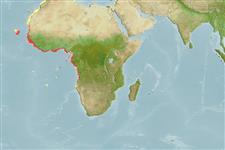Common names from other countries
>
Mulliformes (Goatfishes) >
Mullidae (Goatfishes)
Etymology: Pseudupeneus: Greek, pseudes = false + Peneus, the name of a river.
More on author: Cuvier.
Environment: milieu / climate zone / depth range / distribution range
Ökologie
seewasser demersal; tiefenbereich 10 - 300 m (Ref. 4845), usually 20 - 75 m (Ref. 27000). Tropical; 35°N - 17°S
Western Mediterranean Sea, eastern Atlantic: Morocco to Angola, including offshore islands.
Length at first maturity / Size / Gewicht / Alter
Maturity: Lm ?, range 13 - ? cm
Max length : 55.0 cm SL Männchen/unbestimmt; (Ref. 4845); common length : 35.0 cm SL Männchen/unbestimmt; (Ref. 4845)
Rückenflossenstacheln (insgesamt) : 8; Rückenflossenweichstrahlen (insgesamt) : 9; Afterflossenstacheln: 0; Afterflossenweichstrahlen: 7.
Inhabits the coastal waters of the continental shelf, over sandy and muddy bottoms (Ref. 2683). Feeds on benthic invertebrates (Ref. 4845).
Life cycle and mating behavior
Maturities | Fortpflanzung | Spawnings | Egg(s) | Fecundities | Larven
Ben-Tuvia, A., 1990. Mullidae. p. 827-829. In J.C. Quero, J.C. Hureau, C. Karrer, A. Post and L. Saldanha (eds.) Check-list of the fishes of the eastern tropical Atlantic (CLOFETA). JNICT, Lisbon; SEI, Paris; and UNESCO, Paris. Vol. 2. (Ref. 7313)
IUCN Rote Liste Status (Ref. 130435)
CITES (Ref. 128078)
Not Evaluated
Bedrohung für Menschen
Harmless
Nutzung durch Menschen
Fischereien: kommerziell
Tools
Zusatzinformationen
Download XML
Internet Quellen
Estimates based on models
Preferred temperature (Ref.
115969): 18.1 - 27.9, mean 25.2 (based on 104 cells).
Phylogenetic diversity index (Ref.
82804): PD
50 = 0.6250 [Uniqueness, from 0.5 = low to 2.0 = high].
Bayesian length-weight: a=0.01047 (0.00635 - 0.01728), b=3.08 (2.94 - 3.22), in cm Total Length, based on LWR estimates for this species & (Sub)family-body (Ref.
93245).
Trophic level (Ref.
69278): 3.2 ±0.41 se; based on food items.
Widerstandsfähigkeit (Ref.
120179): hoch, Verdopplung der Population dauert weniger als 15 Monate. (K=0.5; tm=1).
Fishing Vulnerability (Ref.
59153): Low to moderate vulnerability (30 of 100).
Climate Vulnerability (Ref.
125649): High to very high vulnerability (75 of 100).
